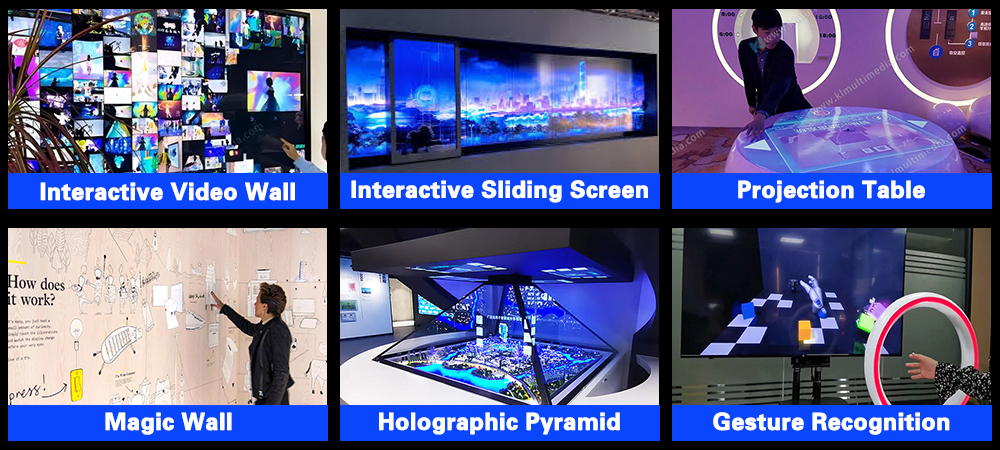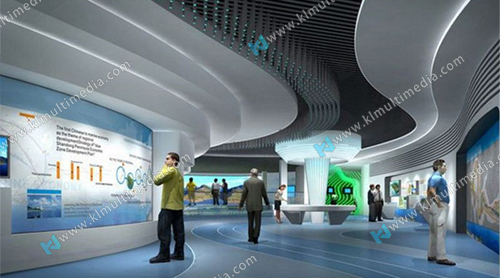
The Interactive wall products can be applied to the walls of Interactive Museum Exhibits. They can display various types of images and video information. Below we show you six interactive wall products suitable for Museum Exhibits.
These interactive exhibits utilize multiple senses—sight, hearing, touch—to create an immersive museum experience. They make abstract concepts tangible and easier for visitors of all ages to understand and remember.
These desktop display products feature the latest creative designs. By combining these innovative designs with your interactive museum, which can greatly improve the experience of the whole exhibition hall.
This is an exhibition that does not need to touch the screen directly, but only needs to interact with digital content remotely through gestures or body movements.That sounds interesting, doesn't it?
The following are all kinds of interactive exhibition equipment in the exhibition hall, the devices can help you better showcase your exhibition content.
As an interesting museum display device, interactive exhibition combines various advanced interactive technologies and various artistic installations, which greatly enhances the enthusiasm and enthusiasm of participants through the personal participation of visitors.
1 Figure out the content that the client wants each exhibit to highlight.
2 Recommend appropriate interactive exhibition items based on the client's actual museum space. You can refer to various interactive exhibition items provided by KLEADER on this page, each of which has detailed videos, such as interactive walls, interactive tables, sensing installations, immersive experiences, etc.; provide the videos downloaded for free from KLEADER's website to the client for secondary confirmation.
3 Display the software materials or game content, and modify and customize them according to the theme that the client intends to express.
4 Install and debug the entire set of interactive exhibition item systems.

Science Centers
Many science museums utilize interactive exhibits that allow visitors to experiment with scientific principles, such as building structures, conducting experiments, or exploring virtual environments.

Art Museum
Some art museums incorporate interactive elements like digital projections, touch-sensitive displays, or even physical installations that visitors can manipulate.

Museums of History and Culture
These museums might use interactive maps, timelines, or audio-visual presentations to allow visitors to delve deeper into the subject matter.

Trade Shows and Exhibitions
Interactive exhibits are increasingly popular in trade shows and exhibitions, providing a dynamic and engaging way for companies to showcase their products and services.Interactive Museum Exhibits is one of the most popular and applied products in the fields of museum interactive display ideas. Digital museums can enhance the audience's sense of experience and participation through interactive display, multimedia technology and other means and improve the attraction and influence of the museum.
So how to make an exhibition interactive? Compared with traditional exhibitions, interactive exhibitions refers to the use of digital technology to digitize museum cultural items to create a virtual and interactive museums display form. Therefore, it is the latest direction of future exhibitions to make use of modern digital technology to make all kinds of traditional exhibitions interactive, interesting and innovative.
Interactive museum exhibits are revolutionizing the way visitors experience museums. Here are some key features of interactive museum exhibits:
1.Hands-On Learning: Unlike traditional exhibits, interactive exhibits invite visitors to touch, manipulate, and explore.
2.Multisensory Engagement: Interactive exhibits often incorporate multiple senses, including sight, sound, and touch.
3.Technology Integration: Many interactive exhibits utilize cutting-edge technology, such as augmented reality (AR), virtual reality (VR), and interactive touchscreens. These technologies provide dynamic and personalized experiences, making the exhibits more appealing to tech-savvy audiences.
4.Increased Engagement:Visitors are more likely to be captivated and spend more time at exhibits that offer interactive elements.
5.Enhanced Communication:Interactive elements can facilitate communication and collaboration between visitors.
6.Memorable Experiences:Interactive exhibits often create more lasting and positive impressions on visitors.
A virtual museum exhibition is an online presentation of museum collections, artifacts, or exhibits, allowing users to explore and interact with them digitally. These exhibitions can include 3D models, high-resolution images, videos, and interactive elements, providing an immersive experience

The Interactive wall products can be applied to the walls of Interactive Museum Exhibits. They can display various types of images and video information. Below we show you six interactive wall products suitable for Museum Exhibits.
These interactive exhibits utilize multiple senses—sight, hearing, touch—to create an immersive museum experience. They make abstract concepts tangible and easier for visitors of all ages to understand and remember.
These desktop display products feature the latest creative designs. By combining these innovative designs with your interactive museum, which can greatly improve the experience of the whole exhibition hall.
This is an exhibition that does not need to touch the screen directly, but only needs to interact with digital content remotely through gestures or body movements.That sounds interesting, doesn't it?
The following are all kinds of interactive exhibition equipment in the exhibition hall, the devices can help you better showcase your exhibition content.
As an interesting museum display device, interactive exhibition combines various advanced interactive technologies and various artistic installations, which greatly enhances the enthusiasm and enthusiasm of participants through the personal participation of visitors.
1 Figure out the content that the client wants each exhibit to highlight.
2 Recommend appropriate interactive exhibition items based on the client's actual museum space. You can refer to various interactive exhibition items provided by KLEADER on this page, each of which has detailed videos, such as interactive walls, interactive tables, sensing installations, immersive experiences, etc.; provide the videos downloaded for free from KLEADER's website to the client for secondary confirmation.
3 Display the software materials or game content, and modify and customize them according to the theme that the client intends to express.
4 Install and debug the entire set of interactive exhibition item systems.

Science Centers
Many science museums utilize interactive exhibits that allow visitors to experiment with scientific principles, such as building structures, conducting experiments, or exploring virtual environments.

Art Museum
Some art museums incorporate interactive elements like digital projections, touch-sensitive displays, or even physical installations that visitors can manipulate.

Museums of History and Culture
These museums might use interactive maps, timelines, or audio-visual presentations to allow visitors to delve deeper into the subject matter.

Trade Shows and Exhibitions
Interactive exhibits are increasingly popular in trade shows and exhibitions, providing a dynamic and engaging way for companies to showcase their products and services.Interactive Museum Exhibits is one of the most popular and applied products in the fields of museum interactive display ideas. Digital museums can enhance the audience's sense of experience and participation through interactive display, multimedia technology and other means and improve the attraction and influence of the museum.
So how to make an exhibition interactive? Compared with traditional exhibitions, interactive exhibitions refers to the use of digital technology to digitize museum cultural items to create a virtual and interactive museums display form. Therefore, it is the latest direction of future exhibitions to make use of modern digital technology to make all kinds of traditional exhibitions interactive, interesting and innovative.
Interactive museum exhibits are revolutionizing the way visitors experience museums. Here are some key features of interactive museum exhibits:
1.Hands-On Learning: Unlike traditional exhibits, interactive exhibits invite visitors to touch, manipulate, and explore.
2.Multisensory Engagement: Interactive exhibits often incorporate multiple senses, including sight, sound, and touch.
3.Technology Integration: Many interactive exhibits utilize cutting-edge technology, such as augmented reality (AR), virtual reality (VR), and interactive touchscreens. These technologies provide dynamic and personalized experiences, making the exhibits more appealing to tech-savvy audiences.
4.Increased Engagement:Visitors are more likely to be captivated and spend more time at exhibits that offer interactive elements.
5.Enhanced Communication:Interactive elements can facilitate communication and collaboration between visitors.
6.Memorable Experiences:Interactive exhibits often create more lasting and positive impressions on visitors.
A virtual museum exhibition is an online presentation of museum collections, artifacts, or exhibits, allowing users to explore and interact with them digitally. These exhibitions can include 3D models, high-resolution images, videos, and interactive elements, providing an immersive experience